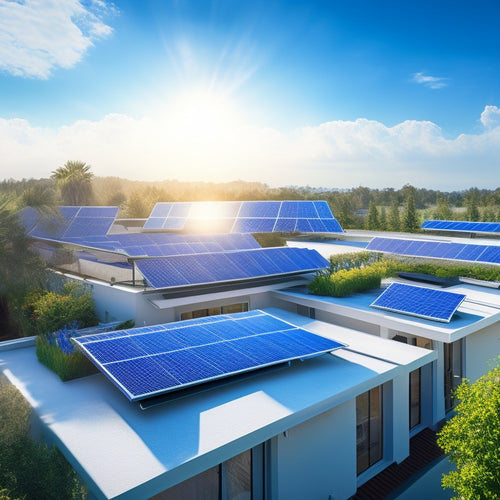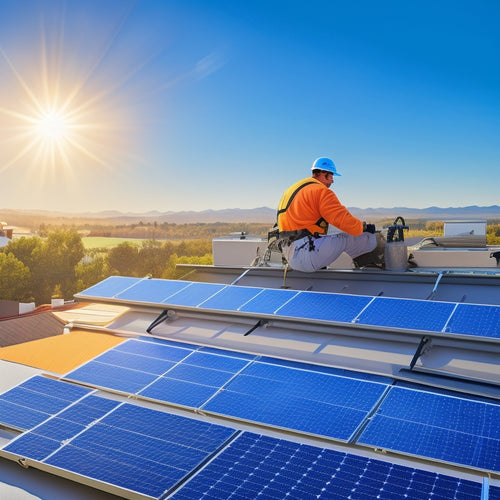
Why Residential Solar Panel Maintenance Costs Matter
Share
As a residential solar panel owner, you've invested in a sustainable energy solution, but neglecting routine maintenance can silently erode your system's performance, leading to reduced energy output and increased repair costs over time. Regular maintenance is essential to minimize degradation effects and maintain peak performance. Neglecting maintenance results in reduced energy efficiency and increased repair costs. By understanding the hidden costs of neglecting maintenance and the importance of regular inspections, you can identify potential issues early, prevent premature system failure, and optimize your energy output. Now, discover how to maximize your system's potential.
Key Takeaways
• Regular solar panel maintenance helps prevent energy output degradation, reducing energy bills and ensuring optimal system performance.
• Neglecting maintenance leads to reduced energy efficiency, increased repair costs, and premature system failure.
• Cleaning solar panels every 6-12 months maintains energy output, reduces costs, and prolongs system lifespan.
• Scheduled maintenance and inspections help identify potential issues early, minimizing repair costs and ensuring warranty validity.
• Proper maintenance extends system lifespan, reduces water consumption, and minimizes environmental impact, making it a crucial investment for residential solar panel owners.
Understanding Solar Panel Degradation
Your solar panels will inevitably degrade over time, reducing their energy output and overall performance. This degradation can be attributed to various factors, including exposure to harsh weather conditions, manufacturing defects, and normal wear and tear.
As a result, your once-efficient solar panels will start to underperform, producing less energy than they did when they were first installed. This not only affects your electricity bill but also the climate impact of your solar panel system.
A 1% annual degradation rate mightn't seem like a lot, but it can add up over time, reducing your system's energy output by as much as 20% over its 20-year lifespan. To put this into perspective, a 10 kW system producing 12,000 kWh of electricity per year could lose around 2,400 kWh annually due to degradation.
This translates to a significant reduction in your system's climate impact, making regular maintenance essential to maximizing your energy output and minimizing your carbon footprint. By understanding the effects of degradation, you can take proactive steps to maintain your solar panels and ensure they continue to perform at their best.
Hidden Costs of Neglecting Maintenance
As you weigh the costs of maintaining your residential solar panel system, it's important to take into account the hidden costs of neglecting regular maintenance.
If you don't stay on top of cleaning, inspections, and repairs, you'll likely face reduced energy efficiency, increased repair costs, and even system failure risks down the line.
Reduced Energy Efficiency
Failing to maintain your solar panels can lead to a significant decline in energy efficiency, translating to reduced power output and increased electricity bills. You invested in solar panels to cut down on energy costs, not to watch them dwindle away due to lack of maintenance. Neglecting regular cleaning, inspections, and repairs can cause your system's performance to dwindle, resulting in reduced energy savings.
To put this into perspective, a study by the National Renewable Energy Laboratory found that dirty solar panels can result in energy losses of up to 25%. That's a significant chunk of change you could be saving on your energy bills!
By monitoring your system's performance metrics, you can identify potential issues before they become major problems. Regular maintenance ensures your solar panels operate at peak levels, maximizing your energy savings and reducing your reliance on the grid.
Don't let neglect eat into your energy savings – prioritize maintenance to keep your solar panels humming along efficiently.
Increased Repair Costs
When you neglect regular maintenance, you're basically gambling on costly repairs down the line, as undetected issues can escalate into major problems that can break the bank. Think of it like playing a game of solar panel roulette - you might get lucky, but the odds are against you.
Here's a breakdown of what you can expect to pay when maintenance is neglected:
| Issue | Average Cost |
|---|---|
| Loose connections | $100-$300 (labor costs) + $50-$100 (material costs) |
| Dirty panels | $200-$500 (labor costs) + $100-$200 (material costs) |
| Inverter failure | $500-$1,000 (labor costs) + $500-$1,000 (material costs) |
| Faulty wiring | $300-$700 (labor costs) + $200-$500 (material costs) |
As you can see, the costs can add up quickly. And that's not even considering the potential damage to your home or business. By neglecting maintenance, you're not only risking financial losses but also putting your property at risk. So, don't gamble with your solar panel system - prioritize regular maintenance to avoid these costly repairs.
System Failure Risks
Your neglected solar panel system can suddenly shut down, leaving you in the dark and facing costly downtime, with each day of system failure potentially costing you hundreds of dollars in lost energy production. This isn't a risk you want to take, especially considering the consequences of system failure can be far-reaching.
Here are just a few of the hidden costs of neglecting maintenance:
-
Battery drainage: A faulty system can drain your batteries, reducing their lifespan and requiring costly replacements.
-
Grid instability: A malfunctioning system can disrupt the grid, causing power outages and instability in your neighborhood.
-
Fire hazards: Overheated or damaged components can spark fires, putting your home and family at risk.
- Compliance issues: Failing to maintain your system can lead to non-compliance with local regulations, resulting in fines and penalties.
Don't let system failure catch you off guard. Regular maintenance is key to ensuring your solar panel system runs smoothly and efficiently, saving you money and stress in the long run.
Importance of Regular Inspections
Regular inspections are vital to identifying potential issues before they escalate into costly problems, and you can avoid up to 40% of solar panel failures by catching them early. By staying on top of inspections, you'll guarantee your system operates at peak performance, and you'll avoid those pesky surprise repairs that can drain your wallet.
When it comes to inspection intervals, it's essential to establish a regular schedule to catch potential issues before they become major headaches. Typically, inspections should be conducted every 6-12 months, depending on your system's size, age, and environmental conditions.
During these inspections, a trained technician will assess your system's performance, checking for signs of wear, damage, or malfunction. They'll also review your system's safety protocols, ensuring that all electrical connections are secure and meet safety standards.
Cleaning Solar Panels Effectively
When it comes to cleaning your solar panels, you'll want to focus on removing dust and debris that can reduce their energy output.
You'll also need to take into account water efficiency methods to minimize waste and optimize your cleaning process.
Dust and Debris Removal
Dust and debris accumulation on solar panels can reduce their energy output by up to 25%, making regular cleaning a crucial maintenance task. As a homeowner, you want to guarantee that your solar panels are operating at peak performance to maximize your energy savings.
Neglecting to clean your solar panels can lead to reduced energy output, decreased panel longevity, and increased maintenance costs down the road.
Here are some key takeaways to keep in mind when it comes to dust and debris removal:
-
Frequency matters: Cleaning your solar panels every 6-12 months can help maintain excellent energy output.
-
Use the right cleaning solution: A mixture of water and mild soap is recommended to prevent damaging your panels.
-
Avoid using high-pressure washes: These can harm your panels and void your warranty.
- Inspect your panels regularly: Keep an eye out for signs of wear and tear, such as cracks or loose connections.
Water Efficiency Methods
You can optimize your solar panel cleaning process by adopting water-efficient methods that minimize waste and reduce your environmental footprint. One effective approach is to utilize rainwater harvesting systems, which collect and store rainwater for non-potable uses like solar panel cleaning. This method not only reduces your water bill but also decreases your reliance on municipal water supplies.
Another approach is to implement greywater reuse systems, which redirect wastewater from sinks, showers, and washing machines for irrigation and cleaning purposes. This approach can greatly reduce your water consumption and lower your environmental impact.
| Water Efficiency Method | Benefits |
|---|---|
| Rainwater Harvesting | Reduces municipal water consumption, lowers water bill |
| Greywater Reuse | Decreases wastewater generation, reduces water consumption |
| Low-Flow Cleaning | Minimizes water waste, reduces cleaning time |
| Dry Cleaning | Eliminates water usage, ideal for dusty environments |
Identifying Potential System Failures
Identifying potential system failures in your residential solar panel installation requires a combination of regular inspections and performance monitoring to detect anomalies that could indicate underlying issues. You can't just set it and forget it - regular check-ups are essential to make sure your system is running efficiently and effectively.
To identify potential system failures, you'll want to:
-
Conduct regular inspections: Keep an eye out for signs of wear and tear, corrosion, or damage to components.
-
Monitor performance metrics: Track energy output, voltage, and current to detect anomalies that could indicate underlying issues.
-
Perform component analysis: Inspect individual components, such as panels, inverters, and connections, to identify potential faults.
- Use fault prediction techniques: Analyze data and historical trends to predict potential failures before they occur.
The Role of Inverters in Maintenance
During regular maintenance checks, it's important to verify that your inverter is functioning correctly, as it plays a vital role in converting DC power from your solar panels to usable AC power for your home. A faulty inverter can lead to reduced energy output, increased energy bills, and even system downtime.
To avoid these issues, it's vital to perform routine inverter calibration to guarantee peak performance. This calibration process involves adjusting the inverter's settings to match the specific requirements of your solar panel system. By doing so, you can maximize power optimization, reducing energy losses and increasing the overall efficiency of your system.
Additionally, a well-maintained inverter will also help prolong the lifespan of your solar panels, saving you from costly repairs and replacements down the line. So, don't neglect this critical component – make sure to prioritize inverter maintenance to get the most out of your solar investment.
Monitoring System Performance Remotely
Your solar panel system's performance can be monitored remotely through advanced software platforms that track real-time data, enabling swift detection of any potential issues and prompt corrective action. This means you can keep tabs on your energy production, identify areas for improvement, and guarantee your system is running at peak performance.
But that's not all - remote monitoring also allows for:
-
Data Analytics: Get insights into your energy usage patterns and optimize your consumption for maximum savings.
-
Cyber Security: Rest assured that your system's online connectivity is secure, protecting your data and preventing unauthorized access.
-
Real-time Alerts: Receive instant notifications in case of any performance issues, enabling swift troubleshooting and minimizing downtime.
- Predictive Maintenance: Identify potential problems before they occur, reducing the need for costly repairs and replacements.
Scheduled Maintenance Scheduling
By combining remote monitoring with a scheduled maintenance program, you can guarantee that your solar panel system receives regular tune-ups to prevent minor issues from becoming major problems. This proactive approach assures that your system operates at peak performance, maximizing your energy savings and reducing the risk of unexpected downtime.
To make scheduling maintenance a breeze, utilize scheduling tools that allow you to set specific maintenance windows tailored to your system's unique needs. This could include bi-annual inspections, quarterly cleaning, or monthly performance checks. By doing so, you'll avoid costly repairs, reduce energy losses, and maintain your system's warranty.
Plus, with scheduled maintenance, you'll have a paper trail of all services performed, providing valuable documentation for future reference. By staying on top of maintenance, you'll reap the benefits of a well-performing solar panel system, and that's no small change!
Avoiding Premature System Failure
Regular maintenance is crucial to preventing premature system failure, which can result from neglecting minor issues that can escalate into major problems, causing costly repairs and even entire system replacements. As a homeowner, you want to guarantee your solar panel system operates efficiently and effectively for its entire lifespan. Neglecting maintenance can lead to a decrease in panel durability and system longevity.
Here are four ways regular maintenance helps avoid premature system failure:
-
Early detection of issues: Regular inspections can identify minor problems before they become major concerns.
-
Preventing corrosion and damage: Cleaning and inspecting panels can prevent corrosion and damage from debris, dirt, and extreme weather conditions.
-
Optimizing energy output: Maintenance ensures your system is operating at peak performance, maximizing energy output and saving you money.
- Extending system lifespan: Regular maintenance can add years to your system's lifespan, ensuring you get the most out of your investment.
Frequently Asked Questions
Can I Perform Solar Panel Maintenance Myself Safely?
"You can attempt DIY solar panel maintenance, but beware: without proper safety protocols, you're risking life and limb - and your DIY mindset might not be enough to prevent a shocking mistake, literally!"
How Often Should I Inspect My Solar Panel System?
'You should inspect your solar panel system every 6-12 months, performing regular system checks and performance monitoring to guarantee peak energy production, identifying potential issues before they escalate into costly problems.'
Are Solar Panel Warranties Affected by Maintenance Neglect?
You're wondering if neglecting maintenance will void your warranty? Yes, neglect can trigger Warranty Consequences, like Neglect Penalties, reducing or even nullifying your coverage, so stay on top of maintenance to avoid costly surprises!
Can I Clean My Solar Panels With a Pressure Washer?
"When you're tempted to blast those panels clean with a pressure washer, don't! You risk damaging the sealant or stripping the protective coating. Instead, use a soft-bristled brush, mild soap (avoiding soap sensitivity), and deionized water (mindful of water quality) for a safe, effective clean."
Do Solar Panels Require Maintenance During Winter Months?
During winter months, you'll need to clear Winter Debris like snow and leaves from your solar panels to guarantee peak energy production. Frosty Performance won't cut it - regular maintenance is key to maximizing your solar investment.
Related Posts
-

Top Online Stores for Solar Car Accessories
When searching online for solar car accessories, you'll find top retailers like Amazon, REI Co-op, and Best Buy offer...
-

Best Solar Panel Options for Maximum Energy Savings
You can maximize your energy savings with solar panels that boast efficiency ratings above 20%, paired with extensive...
-

3 Essential Steps for Solar Electricity Installation
To guarantee a successful solar electricity installation, you'll need to follow three essential steps. First, assess ...


